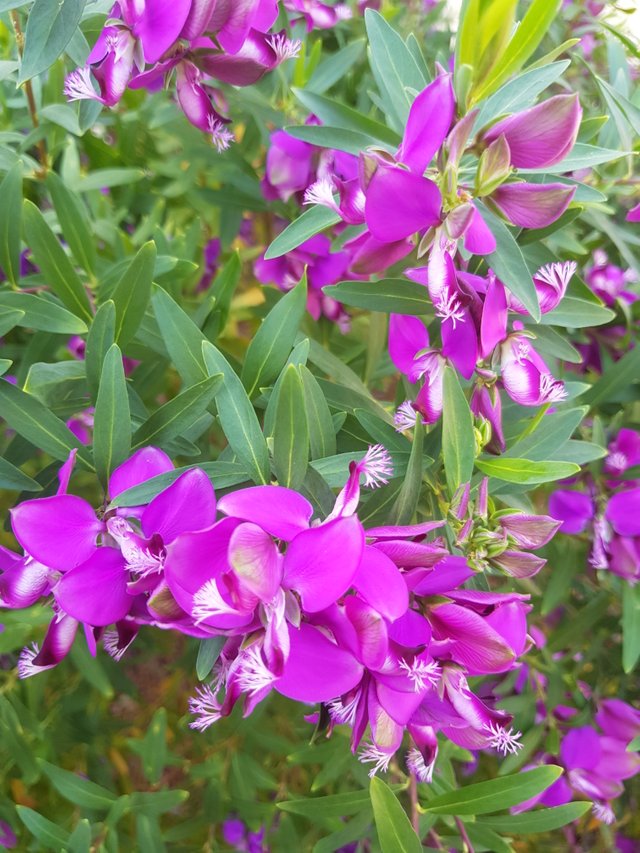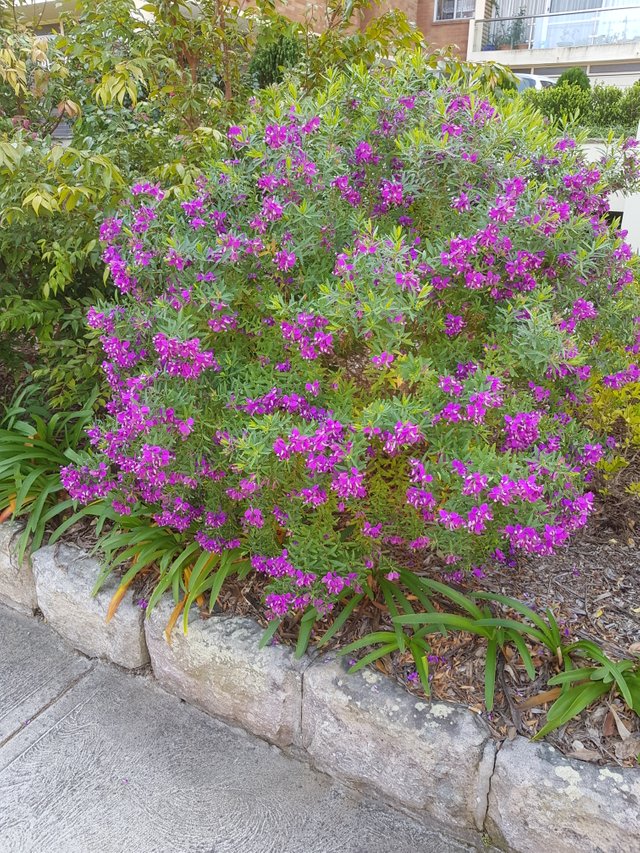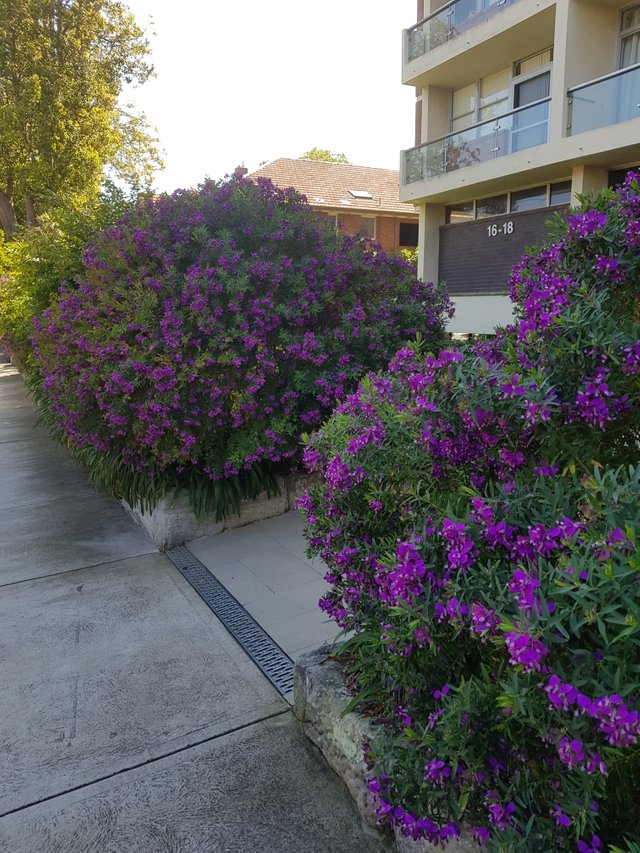Polygala - colour me Mauve
I thought it was Purple, but they say it's Mauve or sometimes Pink. Polygala myrtifolia is sometimes called by the common names "Milkwort" or "Sweet Pea Bush". This time of year in Sydney, there are some nice examples of this plant to see around. This is a fast growing , medium sized shrub, growing up to 2 metres, and it puts on a glorious display of Mauve flowers. It is best planted in full sun and suited for temperate or warm climates. There are some dwarf hybrids available which are suitable for either pots or garden planting, and some prefer these as the regular variety is considered a weed in some places.
These photos were taken in Sydney's Nothern Suburbs. 


Shared on twitter promoting good quality content on #Steemit. Stephen
#Promo-Steem #steemtalent #JoinSteemit #Steemit
Polygala - colour me Mauve. #STEEM #steemtalent #JoinSteemit #Steemit @Steemit
#GardenersWorld #Gardening #Garden #Plants #Australia #Photographer #Photography #Blog #Blogger
https://twitter.com/StephenPKendal/status/1047837792074698752
Polygala of the milkwort family is a genus featuring over 500 species of plants (annuals, herbaceous perennials, subshrubs and shrubs) which are widely distributed in warm to temperate regions throughout the world. Plants are generally noted for having alternate lanceolate leaves and pea-like often showy flowers in terminal clusters/racemes.
Polygala x dalmaisiana, commonly called sweet pea bush or milkwort, is a loose, leggy, fast-growing, rounded to spreading, bushy evergreen shrub which typically grows to 3-5’ tall and as wide. It is reportedly a hybrid between two South African species (P. opposistifolia and P. myrtifolia). Stems are clad with ovate dull green leaves (1” long). Terminal racemes of rose-magenta pea-like flowers with two winged petals surrounding a white purple crest bloom summer to frost, but bloom extends to almost year round in mild frost-free climates with minimum temperatures of 40 degrees F. Flowers resemble those of sweet pea.
Genus name comes from the Greek words polys meaning much and gala meaning milk in reference to a belief dating back to the medieval era that ingestion of plant leaves by certain nursing mammals resulted in increased milk production.
http://www.missouribotanicalgarden.org/PlantFinder/PlantFinderDetails.aspx?taxonid=362665&isprofile=0&
Polygala myrtifolia varies in form as it changes to adapt to the different areas it grows in, from the harshness of the coast to the drier inland climates. An evergreen shrub, the most common forms reach about 0.6 to 1.8 m in height with a few upright-growing stems and slender branches densely covered with leaves that resemble myrtle. The oval-shaped leaves are usually 25-50 mm long and up to 13 mm wide. The leaves are light green, dark green or slightly grey. Some forms of P. myrtifolia have thin, needle-like leaves. It can also grow into a small tree reaching almost 4 m high.
The buds are green, flat, marked with dark veins and oval to half-moon-shaped. The lower buds open first. The flowers are carried in small clusters at the ends of short branches and look a bit like legume (pea or bean) flowers, but are actually quite different. Close inspection will reveal that although they have two wings and a keel, they lack the banner (also called standard) petal. All polygalas also have a showy, and very distinctive brush-like tuft on the keel. The showy petals, beautifully marked with darker veins, are usually in shades of mauve or purple, but can also be pink scarlet, or white. Polygala myrtifolia has blooms throughout the year with a peak in spring ( August to October) when the plants flower profusely. The fruit is a small, winged capsule.
http://pza.sanbi.org/polygala-myrtifolia
@ctrl-alt-nwo,
Wow it's really stunning! The flower looks like an Orchid but with that bush type it's perfect for gardening! Great photography and description! I didn't see this plant in my country! if it's here, it might get a lot of attention from people who loves gardening!
Cheers~
Sweet Pea Bush
To our many customers who have enjoyed the flowering delights of the Sweet Pea Bush (Polygala) and who might well be wondering how to look after this beautiful perennial over winter, read on.
Well as with most things there is no right answer in terms of protection, much depends on the severity of the winter. If your Sweet Pea bush is potted try to move it to the most sheltered part of the garden ideally up against the house, this should offer reasonable protection from the worst of the winter winds, frosts and snow.
If your Sweet Pea bush is planted out, hopefully you remembered to provide a well-drained environment, this above all else will help to keep the Sweet Pea in good shape through the colder months.
The last three winters have been quite mild and haven’t really troubled the Sweet Pea Bush especially here in the South of the UK, but if we do see a very cold winter, wrapping the Sweet Pea bush in hessian or fleece would certainly be beneficial.
Come Spring give the Sweet Pea bush a light prune to keep its rounded shaped and prevent a woody habit.
https://www.athelasplants.co.uk/sweet-pea-bush/
Silly Sausage Award !! Well done , nice selection of Pics.
These are very impressive huge balls of purple flowers!
Lots of fun in these deep colour petals!
I will have to look around here if we have this plant in Thailand.
An attractive evergreen shrub that grows up to 2 meters, the September bush is able to adapt to most garden situations. It is fast growing, making it especially useful for new gardens. Polygala myrtifolia in the wild varies in form according to its habitat and distribution. In some areas it is a tough, loosely branched plant with relatively small, narrow leaves, while in others it is denser with larger, softer leaves. It flowers best in full sun, really dry conditions, poor soil and the least possible care - see natural habitat in photograph 6 above. Good in wild gardens, very dry gardens and exclusion zones.
The September bush will grow in most soil types. Polygala myrtifolia needs very little watering once established. It can be lightly pruned to shape, which encourages a more bushy habit and will keep it within bounds. Left to itself, growth is a bit more lax. Fewer flowers are produced in shady spots. Useful in areas that change from full sun in summer to semi- or full shade in winter.
Source: https://kumbulanursery.co.za/plants/polygala-myrtifolia
Very good-looking flowers there @ctrl-alt-nwo and they do resemble like a flowering pea pod. The color is beautiful with its purple shade.